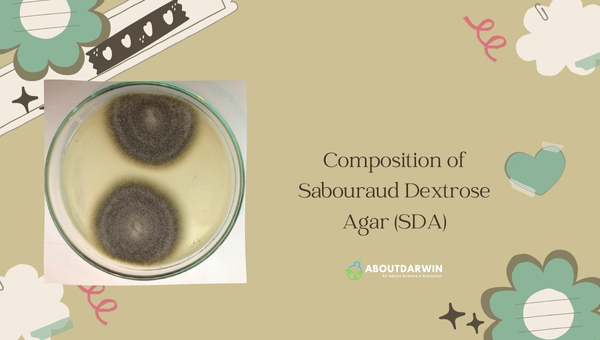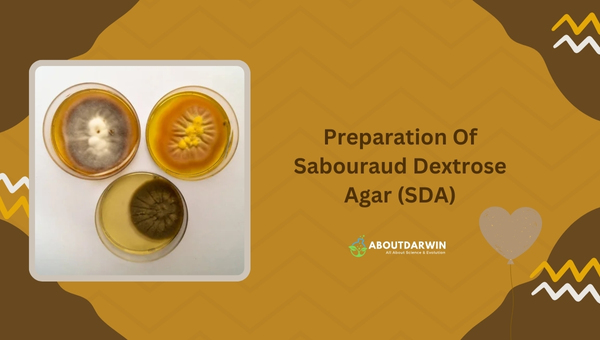Physical Address
304 North Cardinal St.
Dorchester Center, MA 02124
Sabouraud Dextrose Agar (SDA) is a specialized culture medium crucial for the growth of fungi and yeast, first developed by Raymond Sabouraud in 1892.
This unique agar composition not only inhibits bacterial growth but also creates an optimal environment for fungi to thrive, making it indispensable in microbiology labs. As researchers explore the fascinating world of microorganisms, SDA serves as a reliable tool for diagnosing fungal infections and ensuring food safety.
The intricate balance of its ingredients invites curiosity about the microbial life it nurtures and the insights it provides into our understanding of these organisms.
Contents
Sabouraud Dextrose Agar (SDA) is a specialized microbiological growth medium designed specifically for cultivating and isolating fungi. Developed by French dermatologist Raymond Sabouraud in 1892.
This medium has become a cornerstone in mycological research and clinical diagnostics. Its unique composition and acidic pH create an optimal environment for fungal growth while simultaneously inhibiting bacterial proliferation, making it an essential tool for microbiologists studying yeasts, molds, and dermatophytes.
Sabouraud Dextrose Agar (SDA) is a specialized microbiological growth medium designed specifically for cultivating fungi and yeasts.
Its unique composition and acidic pH make it an exceptional tool for isolating and studying various fungal species, particularly those associated with skin infections and dermatophyte research.
Sabouraud Dextrose Agar (SDA) is a specialized microbiological medium used primarily for the cultivation of fungi and yeasts.

Its formulation, often referred to as the Sabouraud dextrose agar composition, is tailored to promote fungal growth while inhibiting bacterial contamination, making it an essential tool in microbiology, especially for isolating organisms linked to skin infections.
The Sabouraud Dextrose Agar Composition includes specific ingredients that create an ideal environment for fungal development:
| Ingredient | Amount (g/L) |
|---|---|
| Dextrose | 40.0 |
| Peptone | 10.0 |
| Agar | 15.0 |
Sabouraud Dextrose Agar (SDA) is a meticulously designed microbiological medium with precisely balanced components that work synergistically to support fungal growth.
Each ingredient plays a critical role in creating an optimal environment for fungal cultivation and research.
Sabouraud Dextrose Agar (SDA) has undergone significant modifications to enhance its utility across different microbiological applications.
The most notable variation is the Emmons modification, which fundamentally altered the medium’s original composition and characteristics.
Also Read: Uncover 1890 Census Substitutes for Genealogical Insights
Sabouraud Dextrose Agar (SDA) is a specialized microbiological growth medium designed specifically for cultivating fungi, yeasts, and molds.
Its unique composition, characterized by a low pH and high dextrose content, creates an optimal environment for fungal growth while simultaneously inhibiting bacterial contamination.

SDA is particularly valuable in identifying and studying dermatophytes, skin-associated fungi, and other microorganisms that require specialized growth conditions.
Preparing Sabouraud Dextrose Agar requires precision and careful technique to ensure optimal fungal growth conditions. The process involves accurately measuring ingredients, dissolving the medium thoroughly, sterilizing through autoclaving, and carefully pouring into sterile containers.
Maintaining proper temperature and pH is crucial for creating an ideal environment for fungal cultivation and research.
Preparing Sabouraud Dextrose Agar requires precision and careful technique to ensure optimal fungal growth. The process involves measuring ingredients accurately, dissolving the medium completely, sterilizing through autoclaving, and carefully pouring the medium into sterile containers.
Following each step meticulously helps prevent contamination and creates an ideal environment for fungal cultivation.
Weighing Ingredients
Dissolving Medium
Sterilization
Cooling & Pouring
Researchers and microbiologists can customize Sabouraud Dextrose Agar to suit specific experimental requirements. By incorporating selective agents like antibiotics, the medium can be tailored to inhibit bacterial growth or target specific fungal species.
Common modifications include adding chloramphenicol to prevent bacterial contamination, gentamicin to control bacterial growth, or cycloheximide to restrict saprophytic fungal development.
Recommended Uses:
Sabouraud Dextrose Agar (SDA) is a specialized microbiological medium designed to optimize fungal and yeast cultivation while inhibiting bacterial growth. Here’s a detailed breakdown of its principles:
The medium’s unique pH of approximately 5.6 plays a crucial role in its effectiveness[3][6]:
SDA acts like a selective “microbial party” where fungi are the preferred guests:
Developed by Raymond Sabouraud in 1892, this ingenious medium continues to be a cornerstone in microbiological research and clinical diagnostics.
Also Read: Uncover 1890 Census Substitutes for Genealogical Insights
Sabouraud Dextrose Agar (SDA) is a specialized growth medium with critical applications in medical and industrial microbiology. Its primary function is the cultivation and identification of fungi and yeasts.
SDA plays a crucial role in diagnostic microbiology by enabling the isolation and identification of various fungal species:
Key Fungal Organisms Cultivated:
Food factories regularly use it to check for unwanted yeast or molds in their products – no one wants surprise fungi turning up in their snacks, after all! It’s also commonly used within water testing laboratories to ensure drinking water safety.
The cosmetics industry is another major consumer of SDA plates. Just as in food processing, these labs use SDA to check their products for mold and yeast contamination. The last thing I’d want is to put on a lotion, knowing it could be hosting a fun, fungal party!
Hopefully, exploring the uses of Sabouraud Dextrose Agar both inside and outside the medical field shines a spotlight on its importance in our daily lives. Stay tuned as we keep peeling away the layers of this fascinating topic!
Also Read: Unraveling C.difficile: An Insight into Biochemical Testing
Sabouraud Dextrose Agar (SDA) is a specialized microbiological growth medium designed specifically for cultivating fungi and certain microorganisms. Environment for fungal growth through its unique composition of nutrients and carefully adjusted pH.
Its selective properties make it an essential tool in microbiology, clinical diagnostics, and research, enabling scientists to isolate and study various fungal species with precision and reliability.
The medium enables the growth of various microorganisms, including yeasts, molds, and specific bacterial species.
Notably, it supports the cultivation of dermatophytes, pathogenic and non-pathogenic fungi, and filamentous bacteria like Nocardia spp.
| Category | Specific Microorganisms | Characteristics | Growth Conditions |
|---|---|---|---|
| Fungi | – Yeasts – Molds – Dermatophytes | Skin and nail pathogens Opportunistic infections Environmental fungi | Low pH (5.6) High dextrose content Inhibits bacterial growth |
| Bacteria | – Nocardia species – Aciduric microorganisms | Filamentous bacteria Acid-tolerant | Slower growth Less competitive environment |
| Clinical Significance | – Candida species – Aspergillus species – Histoplasma | Pathogenic fungi Diagnostic importance | Specialized identification Infection tracking |
In my experience, one of the most fascinating aspects of working with Sabouraud Dextrose Agar (SDA) is observing the varying colony morphologies that develop on the medium.
It’s almost like a living art exhibit when you scrutinize it under laboratory conditions. Different species of fungi and yeast create unique patterns, colors, and textures that offer critical insights into their nature.
Identifying different colonies becomes a matter of keen observation and understanding certain key distinct features exhibited by fungi and yeast as they grow on SDA:
Of course, these are just rough guidelines – any serious study would involve further confirmatory tests such as microscopic examination because some colonies may emulate others in terms of visual characteristics. But overall, understanding colony morphology provides us a headstart in classification.
Also Read: Identification and Biochemical Testing of Streptococcus pyogenes
It’s essential to wear gloves, lab coats, and goggles for protection. Also, always adhere strictly to the prescribed method of preparation and store it adequately.
Yes, avoid contamination during preparation, measure ingredients accurately, ensure a sterile environment & regulate pH correctly to facilitate fungal growth.
While SDA promotes wide-ranging fungi and yeast cultures, it may not be ideal for certain strains – always verify with relevant guidelines.
Factors such as temperature fluctuations, variation in pH levels, or contamination can negatively impact colony morphology on SDA.
Not exclusively! While often used for isolating pathogenic fungi and yeast in medicine, it’s also instrumental within broader food industry quality control checks.
It appears that SDA agar represents a pivotal microbiological medium with significant implications for microbial cultivation and research. The specialized formulation enables precise detection and growth of specific microorganisms, particularly fungi and certain bacterial species.
Researchers consistently rely on this nutrient-rich substrate to conduct comprehensive microbiological investigations, highlighting its critical role in diagnostic and experimental settings.
By providing an optimal environment for targeted microbial growth, SDA agar continues to be an essential tool in scientific and clinical microbiology.